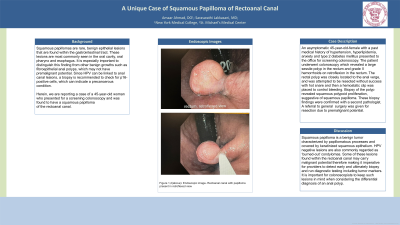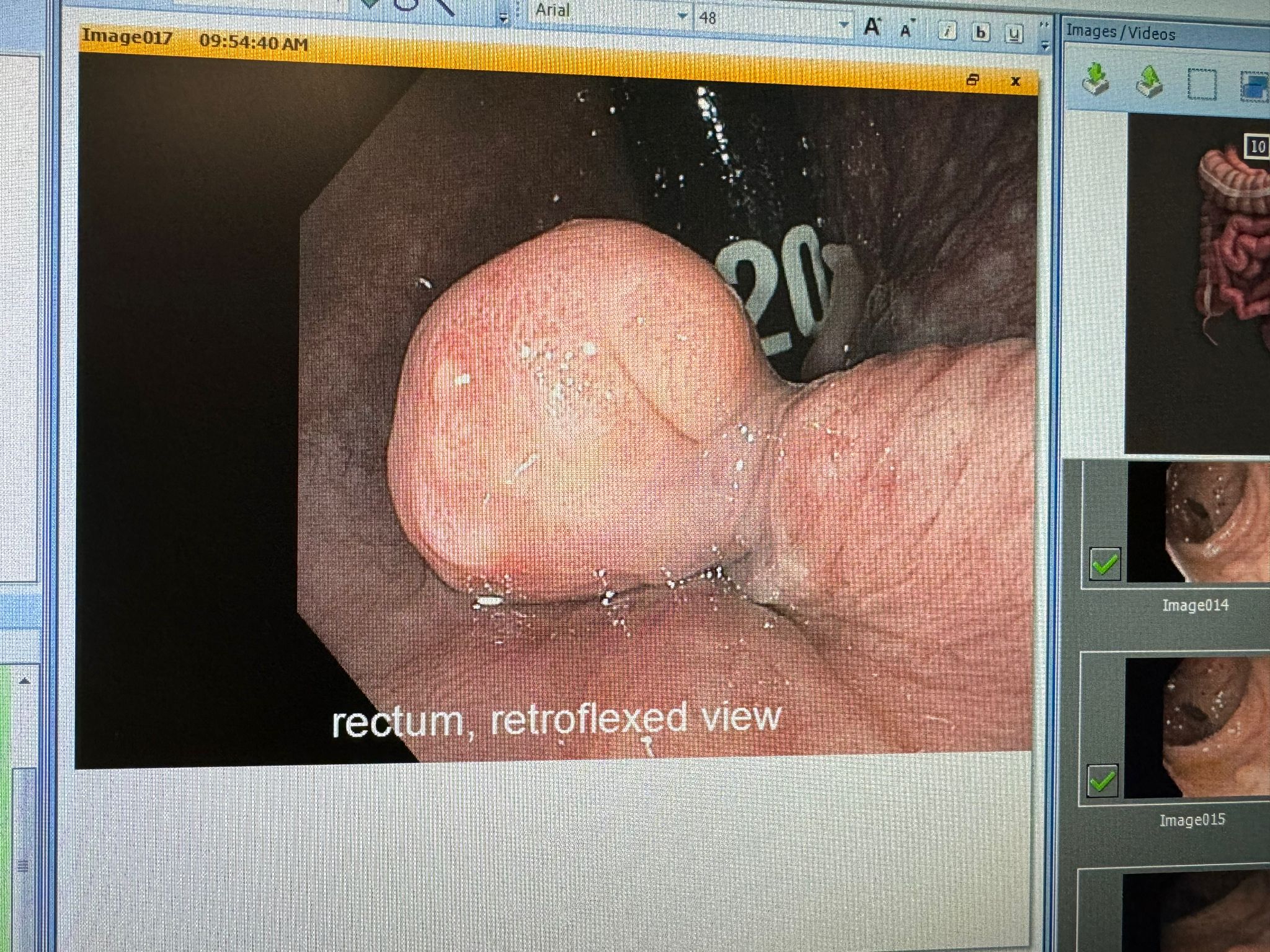Sunday Poster Session
Category: Colorectal Cancer Prevention
P0451 - A Unique Case of Squamous Papilloma of Rectoanal Canal
Sunday, October 27, 2024
3:30 PM - 7:00 PM ET
Location: Exhibit Hall E

Has Audio
- AA
Amaar Ahmad, DO
Saint Michael's Medical Center, New York Medical College
Moorestown, NJ
Presenting Author(s)
Amaar Ahmad, DO1, Saraswathi Lakkasani, MD2
1Saint Michael's Medical Center, New York Medical College, Moorestown, NJ; 2Augusta Health, Glen Allen, VA
Introduction: Squamous papillomas are rare, benign epithelial lesions that are found within the gastrointestinal tract. These lesions are most commonly seen in the oral cavity, oral pharynx and esophagus. It is especially important to distinguish this finding from other benign growths such as fibroepithelial anal polyps, which may not have premalignant potential. Since HPV can be linked to anal canal lesions, a biopsy is recommended to check for p16-positive cells, which can indicate a precancerous condition. Herein, we are reporting a case of a 45-year-old woman who presented for a screening colonoscopy and was found to have a squamous papilloma of the rectoanal canal.
Case Description/Methods: An asymptomatic 45-year-old-female with a past medical history of hypertension, hyperlipidemia, anxiety and type 2 diabetes mellitus presented to the office for screening colonoscopy. The patient underwent colonoscopy which revealed a large sessile polyp in the rectum and grade II hemorrhoids on retroflexion in the rectum. The rectal polyp was closely located to the anal verge, and was attempted to be resected without success with hot snare and then a hemostatic clip was placed to control bleeding. Biopsy of the polyp revealed squamous polypoid proliferation, suggestive of squamous papilloma. These biopsy findings were confirmed with a second pathologist. A referral to general surgery was given for resection due to premalignant potential.
Discussion: The squamous papilloma is a benign tumor characterized by papillomatous processes and covered by keratinized squamous epithelium. HPV negative lesions are also commonly regarded as ‘burned-out’ condylomas. Some of these lesions found within the rectoanal canal may carry malignant potential therefore making it imperative for providers to detect early and ultimately biopsy and run diagnostic testing including tumor markers. It is important for colonoscopists to keep such lesions in mind when considering the differential diagnosis of an anal polyp.

Disclosures:
Amaar Ahmad, DO1, Saraswathi Lakkasani, MD2. P0451 - A Unique Case of Squamous Papilloma of Rectoanal Canal, ACG 2024 Annual Scientific Meeting Abstracts. Philadelphia, PA: American College of Gastroenterology.
1Saint Michael's Medical Center, New York Medical College, Moorestown, NJ; 2Augusta Health, Glen Allen, VA
Introduction: Squamous papillomas are rare, benign epithelial lesions that are found within the gastrointestinal tract. These lesions are most commonly seen in the oral cavity, oral pharynx and esophagus. It is especially important to distinguish this finding from other benign growths such as fibroepithelial anal polyps, which may not have premalignant potential. Since HPV can be linked to anal canal lesions, a biopsy is recommended to check for p16-positive cells, which can indicate a precancerous condition. Herein, we are reporting a case of a 45-year-old woman who presented for a screening colonoscopy and was found to have a squamous papilloma of the rectoanal canal.
Case Description/Methods: An asymptomatic 45-year-old-female with a past medical history of hypertension, hyperlipidemia, anxiety and type 2 diabetes mellitus presented to the office for screening colonoscopy. The patient underwent colonoscopy which revealed a large sessile polyp in the rectum and grade II hemorrhoids on retroflexion in the rectum. The rectal polyp was closely located to the anal verge, and was attempted to be resected without success with hot snare and then a hemostatic clip was placed to control bleeding. Biopsy of the polyp revealed squamous polypoid proliferation, suggestive of squamous papilloma. These biopsy findings were confirmed with a second pathologist. A referral to general surgery was given for resection due to premalignant potential.
Discussion: The squamous papilloma is a benign tumor characterized by papillomatous processes and covered by keratinized squamous epithelium. HPV negative lesions are also commonly regarded as ‘burned-out’ condylomas. Some of these lesions found within the rectoanal canal may carry malignant potential therefore making it imperative for providers to detect early and ultimately biopsy and run diagnostic testing including tumor markers. It is important for colonoscopists to keep such lesions in mind when considering the differential diagnosis of an anal polyp.

Figure: Sessile Polyp, near anal verge
Disclosures:
Amaar Ahmad indicated no relevant financial relationships.
Saraswathi Lakkasani indicated no relevant financial relationships.
Amaar Ahmad, DO1, Saraswathi Lakkasani, MD2. P0451 - A Unique Case of Squamous Papilloma of Rectoanal Canal, ACG 2024 Annual Scientific Meeting Abstracts. Philadelphia, PA: American College of Gastroenterology.
